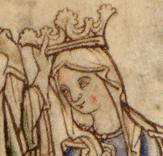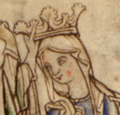Edith of Wessex facts for kids
Quick facts for kids Edith of Wessex |
|
|---|---|

Illustration by Matthew Paris
|
|
| Queen consort of England | |
| Tenure | 23 January 1045 – 5 January 1066 |
| Coronation | 23 January 1045, Old Minster, Winchester |
| Born | c. 1025 |
| Died | 18 December 1075 (aged 49–50) |
| Burial | Westminster Abbey, England |
| Spouse | Edward the Confessor |
| House | Godwin |
| Father | Godwin, Earl of Wessex |
| Mother | Gytha Thorkelsdóttir |
Edith of Wessex was an important Queen of England who lived a long time ago, from about 1025 to 1075. She was married to Edward the Confessor and was Queen from 1045 until he passed away in 1066. It was special for her to be crowned Queen, as not many queens at that time were. Much of what we know about her comes from a book she asked someone to write, called the Life of King Edward.
Early Life and Family
Edith was born around 1025. Her father was Godwin, who was the most powerful earl in England. Her mother, Gytha, was related to the Danish royal family. Edith had many brothers, including Harold, who later became King Harold II. She also had two younger sisters.
Edith grew up at Wilton Abbey, which was a religious house. She was a very educated woman for her time. She learned to speak several languages there. Edith remained connected to Wilton Abbey throughout her life. She even helped rebuild its church later on.
Edith's family faced many challenges. She lost four of her brothers in a very short time in 1066. Tostig died in September during the Battle of Stamford Bridge. Just a few weeks later, Harold, Gyrth, and Leofwine all died in October at the Battle of Hastings.
Life as Queen
Edith married King Edward the Confessor on January 23, 1045. Unlike many queens of that time, she was crowned. They did not have any children.
In 1051, Edith's father and brothers had a disagreement with King Edward. They had to leave England for a short time. During this period, Edith was sent away to a nunnery. However, when her family returned to England in 1052, she was brought back and became Queen again.
As Queen, Edith became one of King Edward's trusted advisers. She was known as a strong and determined woman. She helped manage the King's royal image and even had a goldsmith working for her. When King Edward died, Edith was the richest woman in England. She was also the fourth wealthiest person overall, after the new king, the Archbishop of Canterbury, and her brother Harold.
Edith was very close to her brother Tostig. In 1055, she and Harold helped him become the Earl of Northumbria. However, Tostig's rule was not popular. In 1064, Edith was accused of being involved in the murder of a nobleman to help Tostig. In 1065, the people of Northumbria rebelled against Tostig. They chose Morcar, Harold's brother-in-law, as their new earl. King Edward wanted the rebellion stopped, but Harold and other English nobles refused. Tostig was forced to leave England.
Later Life and Legacy
After King Edward died on January 5, 1066, Edith's brother, Harold Godwinson, became the new king. However, Harold's reign was short. He was killed at the Battle of Hastings in October 1066, when William the Conqueror invaded England.
After the Norman Conquest, Edith was one of the few important members of the Godwin family who remained in England. Her brother Wulfnoth was held captive in Normandy.
Edith continued to be an important figure. She read about English saints and shared information about Saint Kenelm with a writer. She passed away in Winchester on December 18, 1075. She was buried next to her husband, King Edward, in Westminster Abbey. Her funeral was arranged by William the Conqueror.
Some historians believe that Edith of Wessex might have been involved in creating the famous Bayeux Tapestry. This tapestry tells the story of the Norman Conquest.
See also
- House of Wessex family tree
- Godwin family tree
- Cnut the Great's family tree
Images for kids


